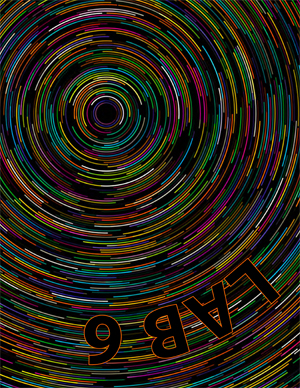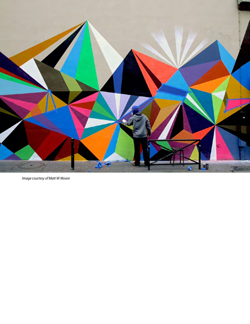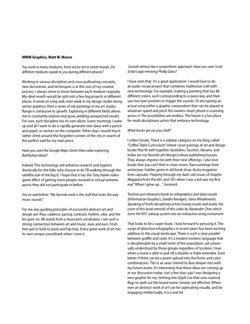You work in many mediums, from vector art to street murals. Do different mediums speak to you during different phases?
Working in various disciplines and cross-pollinating concepts, new discoveries, and techniques is at the core of my creative process. I always strive to move between each medium regularly. My ideal month would be split into a few big projects in different places. A week on a big wall, next week in my design studio doing vector graphics, then a series of ink paintings in my art studio. Range is conducive to growth. Exploring in different fields allows me to constantly explore and grow, yielding unexpected results. For sure, each discipline has its own allure. Some mornings I wake up and all I want to do is rapidly generate new ideas with a pencil and paper, or vectors on the computer. Other days I would much rather climb around the forgotten corners of the city in search of the perfect wall for my next piece.
Have you seen the Google Maps Street View video exploring Battleship Island?
Indeed. This technology will enhance research and logistics drastically for the folks who choose to do their homework. Many countryside graffiti destinations have been discovered while web walking through the satellite eye of the big G. I hope that it has the Tony Hawk videogame effect of getting more people involved in virtual extreme sports they did not participate in before, and inspiring these people to go out and climb under a fence for the real life thrills. It’s a double edged sword, and there are some very obvious flipsides from the side of the illegal artist. All the geo and hash tagging linked with real life graffiti tagging is also assisting the authorities. It’s crazy to think that in the very near future, a prolific street painter’s biggest fans will actually be the detective’s strongest allies.
You’ve said before: “My favorite work is the stuff that looks the way music sounds.”
For me, key guiding principles of successful abstract art and design are: flow, cadence, pacing, contrast, rhythm, vibe, and the list goes on. All words from a musician’s vocabulary. I see such a strong connection between art and music, eyes and ears. From free jazz to funk to punk and hip-hop. Every great work of art has its own unique soundtrack when I view it.
Sounds almost like a synaesthetic approach. Have you seen Scott Snibe’s app remixing Phillip Glass?
I have seen that. It’s a great application. I would love to do an audio-visual project that combines traditional craft with new technology. For example, making a painting that has 88 different colors, each corresponding to a piano key, and then use two laser pointers to trigger the sounds. Or encrypting an actual song within a graphic composition that can be played at whatever speed and pitch the viewers smart phone is scanning across it. The possibilities are endless. The future is a fun place for multi-disciplinary artists that embrace technology.
What books are on your shelf?
I collect books. There is a sidebar category on my blog called “Coffee Table Curriculum” where I post pairings of art and design books that fit well together. Gestalten, Taschen, Abrams, and Index are my favorite art/design/culture publishing houses. They always impress me with their new offerings. I also love books that you can’t find in chain stores. Rare printings from yesteryear, hidden gems in old book shop, dusty magazine time capsules. Flipping through my dad’s old issues of Graphis Magazine from the 60’s and 70’s when I was a kid was my first real “When I grow up…” moment.
Taschen just released a book on infographics and data visuals (Information Graphics, Sandra Rendgen, Julius Wiedemann). Speaking of multi-disciplinary artists fusing visuals and audio, the cover of this book reminds of this video by Alexander Chen which turns the NYC subway system into an interactive string instrument.
That looks to be a super book. I look forward to perusing it. The surge of attractive infographics in recent years has been exciting addition to the visual landscape. There is such a clear parallel between graffiti and code. It’s a modern esoteric language that is decipherable by a small niche of the population, yet universally understood by these groups regardless of location. I love when a mural is able to pull off a double or triple entendre. Even better if there can be a poem spliced into the forms and color combinations. This is an area I intend to dive deeper into with my future works. It’s interesting that these ideas are coming up in our discussion today. Just a few days ago I was designing a new graphic for my clothing line Glyph Cue that uses nautical flags to spell out the brand name. Simple, yet effective. Whenever an abstract work of art can be captivating visually, and be engaging intellectually, it is a real hit.
Do you think the act of deciphering encourages a deeper level of engagement with the artwork? In a recent project, the MIT Media Lab has drawn a parallel between graffiti and code, suggesting that “graffiti codes allow users to encode a small piece of information into a physical space, much like a QR code.”
I’ve found that people really enjoy the process of discovery when viewing artwork. In the graffiti world there are four general groups of viewers. The participants who can crack just about any wildstyle piece with ease just through their immersion in the sport, the fans of graffiti who enjoy trying to read the hidden message, the folks who can’t read the message but still love the colorful presence of the image, and the final group, the folks who dismiss the entire thing because they know it says something and they cannot decipher it and this is daunting, or scary, for them. This final group can easily be split into two different groups once the artwork becomes an abstract mural without any hints of letterforms. At that point, people either enjoy the energy of the piece or not. That has always fascinated me since I work in various styles, sometimes painting letters, and other times painting pure abstractions. It’s amazing to have a grandfather, his daughter, and her son all walk by and give thumbs up to a colorful mural. Most of the time, if it were a traditional graffiti piece, the only kudos would be from the kid. The whole QR code thing is an interesting evolution, and it’s still so early in it’s development. It was laughable a few years back when they were everywhere. I mean seriously, no one was pulling out their smart phone at the BBQ to scan the ketchup bottle and go to a special website, but the thing was still plastered on there. The project by the MIT Lab sounds very cool, but it is still just the tip of the iceberg. Within a few years I see this whole concept and functionality of the smart phone image scan being in a more mature phase where you can scan just about anything and get info on it. How old is that building? Snap an iPhone picture of it and read the entire history. Is that a pimple or lyme disease? Snap a pic. Who painted that wall, and when, and with what brand paint? Point your phone at it and send the capture through the user generated info vortex. Fascinating. And sooner than most people think.
Yes. I can imagine something where you take a photo of a building and immediately have access to data about year of constuction of the building, trends in urban development, info about the architect, historical events that happened on the street in front of that building, pedestrian traffic density, public transportation nearby, info about artists who have put up murals in the surrounding blocks. It could be overwhelming at first, but it seems navigating data will become more and more about choosing your filters carefully than reducing the amount (or complexity) of data. Speaking of accessibility, murals and walls that are in hidden places bring to mind the tradition of hidden fore-edge paintings in books, while public installations bring to mind the performance art spirit of Burning Man. It seems both are ways of speaking to different audiences, but with different voices and vocal tones, and in a different time scale.
That is a great comparison. I agree, true graffiti is about leaving no trace and being ninja style. And painting a big public wall can often times feel like a stage performance. I enjoy both for different reasons. It is a peaceful and satisfying act to hide a work of art in a shadowy corner of the city, and it is also exciting to be downtown with an audience watching every move. In these situations some fun interactions occur. Neighborhood people suggest what the art should be, kids sneak in and paint their names on my wall with my paint while I’m up un the ladder with my back to them, the downtown riffraff are always stopping to explain the action-packed plot to their real-life movie, and the list goes on. Totally different energy.
An immersive, engaging experience. Sounds like something straight out of a Jane Jacobs book. Or Sesame Street episode. Scariest experience creating a wall?
My first time painting a huge mural on a lift was a real highlight. As far as scary times go, the list is long and the stories range from funny to disturbing. A couple months ago I was painting an abandonded spot in Paris and a bunch of agro squatters on the roof 6 flights up started throwing stuff at me. Flourescent light tubes, rocks, anything they could find up there. I was all in my zen moment, ground level, getting close to wrapping up my piece, and all of a sudden it’s raining glass and rocks. Luckily I did not get hit, but it was one hell of an alarm clock to dip out of there.
Did you get to finish the piece?
I took a stroll and scoped the wall from afar. It was in the phase of being fixed and chopped up, something I probably do too much of when the spot is not a cake walk. I decided to call it done, went back and got a photo, and let the optimist in me see it as a sign that I should relax on the small details of my walls. I would have been on the train home and that would not have happened if I wasn’t so obsessed with being hyper clean with the finishing touches.
So many times, stepping back allows us the wider perspective that we need to come back to a project with a new vision, like with George Rousse’s anamorphic perspective installations. Speaking of the bigger picture, you’ve done some absolutely massive pieces. What’s been your experience with creating these large scale pieces with large audiences?
Rousse is a genius. He must have so much fun planning and creating those designs. I love the concept of art that can only be viewed from only one vantage point. I would love to see videos of his installations where the camera is doing a walk through and then for an instant it all makes sense. I wonder if he has done that yet? In my work, “more is more” and I am constantly trying to line up bigger and more elaborate walls and installations in the most visible and cool settings. In the past five years I have been really lucky to have opportunities painting large commissioned murals in cities all over the world. Moscow, Barcelona, New York, Paris, Los Angeles, Boston, Portland, Tokyo, Marseille, Lyon, San Francisco, Vienna, and more. Traveling to new places and leaving my artwork on the walls for the people to experience is a dream come true.
Some of Banksy’s walls are being removed and auctioned (prices ranging from $300,000 to 1.1 million).
It’s cool that the bankmeister is still out there painting illegally. I wonder if he gets a slice when a wall sells for a milli? I sure wouldn’t let that happen twice without getting a nice cut. If you can’t stop them, tax them. Who knows, really, you know? It’s stories like this that make stars even bigger. Perception is nine tenths of reality. As long as his actions in the street are for the neighborhood people, then it’s honest, and I support it. If nothing more, it’s at least shifting the public’s perception of the value of spray-painted art. Hopefully less graffiti cats are in the position of explaining they need more than a case of paint and a six pack of beer when they are being commissioned to paint a wall.
The moment that you knew you were hooked on street art.
My first box of crayons — and having them taken away — and the burning desire to locate them.
Beautiful. If you could put up a mural in any location in the world?
I would love to fly a crop duster filled with colored water over Antarctica.
You should talk to Jim Denevan. You’re both amazing artists, and I could see you two exchanging some interesting perspectives on large-scale art.
Another genius, Denevan is creating some revolutionary installations. I hope to work that large one day. I gravitate to the impermanence of his work as well. Modern mandalas. His creations fascinate my eyes and my mind. The designer in me is in awe of the aesthetics and craft, and the engineer in me is trying to imagine how to plot some of those intricate ones out. I would definitely enjoy collaborating with artists like Denevan.
What inspires you in the morning?
I get hyped surfing the web and checking out the recent works of my friends all over the world. I am truly blessed to have so many talented and unique creative friends. Then it’s good music, healthy food, strong coffee, and back to lab. •



